Next-Level Leader

The Appleton Greene Corporate Training Program (CTP) for Next-Level Leader is provided by Ms. Pruyne Certified Learning Provider (CLP). Program Specifications: Monthly cost USD$2,500.00; Monthly Workshops 6 hours; Monthly Support 4 hours; Program Duration 12 months; Program orders subject to ongoing availability.

Personal Profile
Ms. Pruyne is a highly respected and sought-after Global Leadership Advisor, Consultant, and Coach. Offering 25+ years of experience working with the C-suite, executive/divisional management, their direct reports, and teams. Partnering with leaders across IBM, Booz Allen Hamilton, BBDO, The BAM Connection, Hilton, Leidos, Grey, Yale School of Medicine, Landis, and the Discovery Channel.
Recently, she redesigned two global internal advertising agencies. Ms. Pruyne is a founding C-suite and Executive Management Coach for the fastest-growing executive women’s network. Since 2020, she has delivered more than 95 interviews with top-level executives and business leaders who peel back the curtain, sharing the truth of what it took to achieve their success on her Radio Podcast.
As EVP and Global Director of Creative Management for one of the world’s largest advertising agencies, she managed 500+ team members across 80 international offices. She developed the company’s first-ever “Global and Regional Creative Councils” to foster cross-country communication and collaboration between 200+ international creative directors. She literally elevated leadership in North America, South America, Europe, and the Asia Pacific. For nearly 15 years, she built the creative industry’s global standard for employee engagement, operations, and profitability.
Impact leadership transformations are delivered through one-to-one engagements, corporate training programs, workshops, off-sites, retreats, and keynote presentations. Frequently brought in by the C-suite to ensure their next-level of management has all they need to be the success the company needs them to be.
Ms. Pruyne has been a Founder & CEO for the past 17 years. Her firm is known for leading executive advisement, consulting, and coaching, specializing in transforming executives, entrepreneurs, and professionals to become the leaders others choose to follow in today’s ever-changing business market.
Ms. Pruyne brings her vast global experience, innovation, creativity, strategy, and fun to every coaching or consulting engagement. She holds a Bachelor of Fine Arts in Communications & Theatre from New York University and has a Corporate, Executive, and Personal Development Coach Certification from the Coaches Training Institute (CPCC).
To request further information about Ms. Pruyne through Appleton Greene, please Click Here.
(CLP) Programs
Appleton Greene corporate training programs are all process-driven. They are used as vehicles to implement tangible business processes within clients’ organizations, together with training, support and facilitation during the use of these processes. Corporate training programs are therefore implemented over a sustainable period of time, that is to say, between 1 year (incorporating 12 monthly workshops), and 4 years (incorporating 48 monthly workshops). Your program information guide will specify how long each program takes to complete. Each monthly workshop takes 6 hours to implement and can be undertaken either on the client’s premises, an Appleton Greene serviced office, or online via the internet. This enables clients to implement each part of their business process, before moving onto the next stage of the program and enables employees to plan their study time around their current work commitments. The result is far greater program benefit, over a more sustainable period of time and a significantly improved return on investment.
Appleton Greene uses standard and bespoke corporate training programs as vessels to transfer business process improvement knowledge into the heart of our clients’ organizations. Each individual program focuses upon the implementation of a specific business process, which enables clients to easily quantify their return on investment. There are hundreds of established Appleton Greene corporate training products now available to clients within customer services, e-business, finance, globalization, human resources, information technology, legal, management, marketing and production. It does not matter whether a client’s employees are located within one office, or an unlimited number of international offices, we can still bring them together to learn and implement specific business processes collectively. Our approach to global localization enables us to provide clients with a truly international service with that all important personal touch. Appleton Greene corporate training programs can be provided virtually or locally and they are all unique in that they individually focus upon a specific business function. All (CLP) programs are implemented over a sustainable period of time, usually between 1-4 years, incorporating 12-48 monthly workshops and professional support is consistently provided during this time by qualified learning providers and where appropriate, by Accredited Consultants.
Executive summary
Next-Level Leader
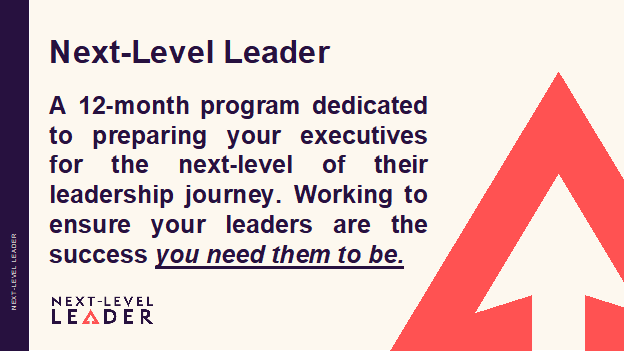
History
In the ever-changing business world today, ensuring your leaders have all they need to be the success you need them to be is more critical than ever. Too frequently, executives are promoted to the next level of leadership without the professional development, personal growth, and guidance for them to succeed in this new position.
The big question then becomes, should we have promoted this individual, and do they have it in them to be successful in this new role? The more powerful question to ask is, what does this person need to be a success?
Much like you can’t use yesterday’s technology to solve today’s technical challenges. The same is true for leadership. Yesterday’s leadership protocols will not be of value or help with today’s business and company challenges.
When a leader is ill-prepared for the next level of leadership, it has a widespread impact on the company. The company impact is primarily focused on three areas: Financial, Legal, and On-going Performance. All of this costs the company money that could be better spent elsewhere.
Financial
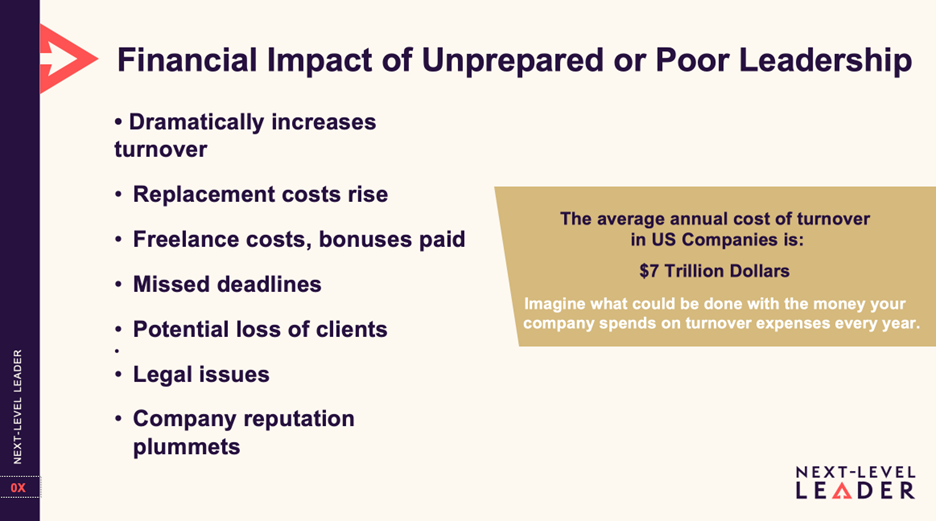
The financial impact of unprepared or poor leadership begins with the turnover costs, which continue to rise. These costs can include special payouts, vesting stock early, recruiter fees, freelance and/or bonuses paid, sign-on bonuses, stock options, training, and the list goes on. By the time you identify a replacement, you will have paid an average of double the person exiting salary, and, in the C-Suit, it can be as much as 200% of their annual salary or more. Money is also allocated to retaining the employees impacted engaged, performing at a high, and delivering work on time.
It is a ripple effect that continues throughout the company. Some costs are easy to quantify immediately, and others will become clear over time.
Legal
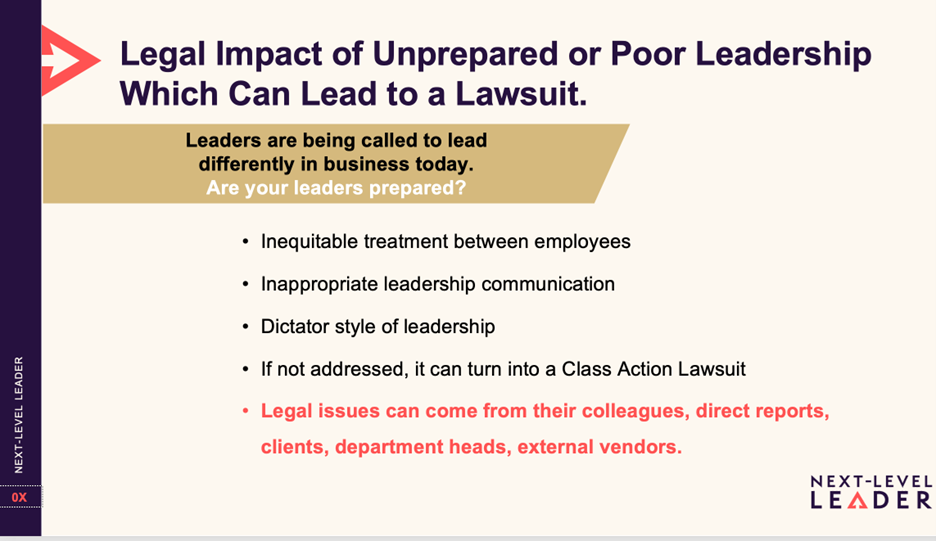
The challenges of unprepared or poor leadership elevate the risk factor for a variety of different types of lawsuits. The legal issues can come from their colleagues, direct reports, clients, department heads, external vendors, or any sector that the leader interacts with. They can come from inequitable treatment between employees, inappropriate leadership interactions and communication, and dictator leadership style, and if any of these issues are not addressed swiftly with the hopes it will work itself out, it can lead to a potential Class Action suit.
This is not only costly from a financial perspective but also from the company’s reputation. They can become known as a company that tolerates inappropriate leadership, a revolving door of leadership and or staff, or a company that cares more about the bottom line than its people.
On-going Performance
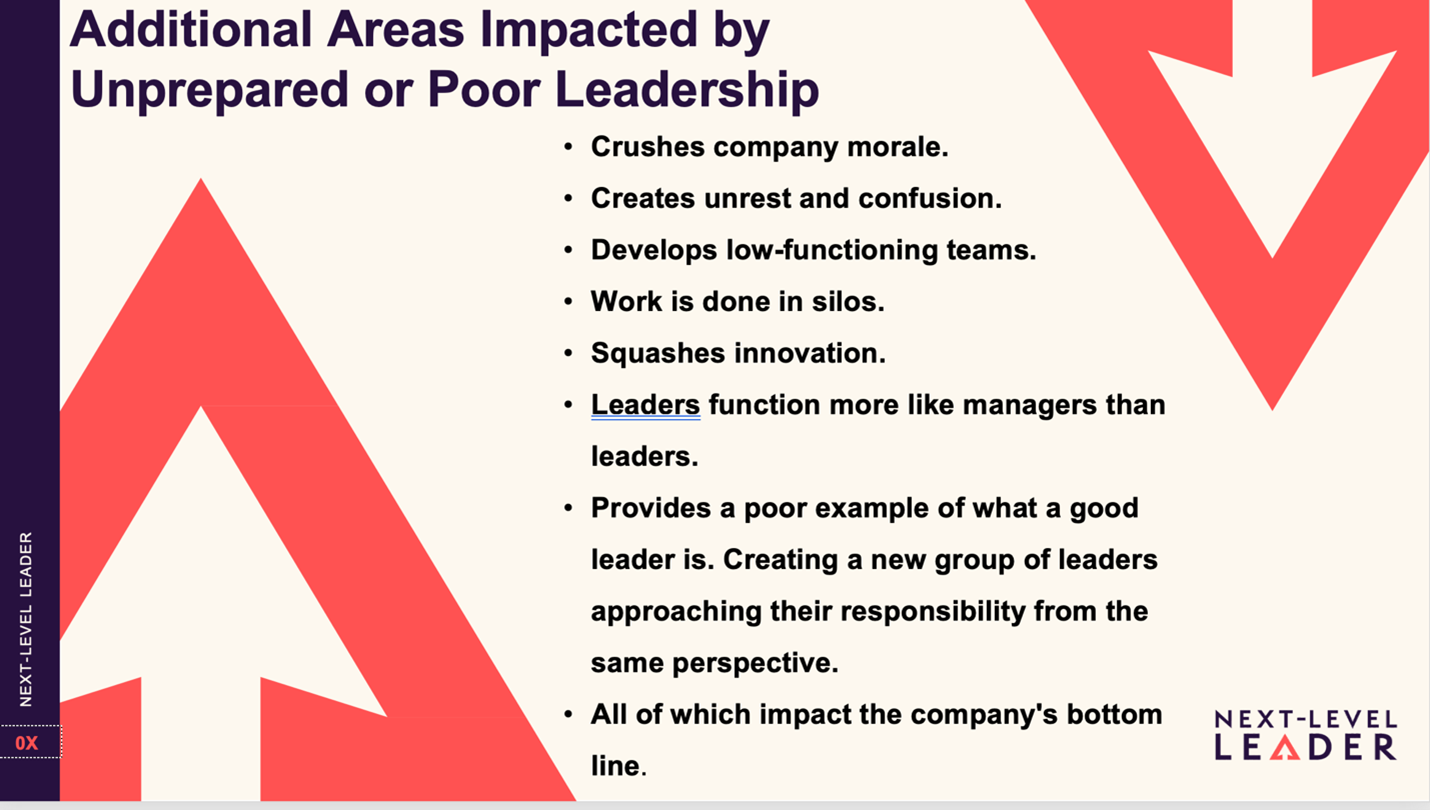
Is not a place that many companies look to quantify the cost of unprepared or poor leadership on their bottom line. When the reality is, the impact is far-reaching.
For example, when someone is promoted to a higher level of responsibility and is not prepared for this new role, it creates challenges for the newly promoted leader and confusion for their direct reports. Subsequently, the quality of the work lessens, deadlines are missed, collaboration is crippled, best solutions are not identified, company morale is squashed, and the list goes on.
It also provides a poor example of what a good leader is. Creating a new generation of leaders approaching their responsibility from the same perspective and style as the unprepared or poor leader. Which ultimately creates bigger challenges for the company and brings us back to increased turnover.
So, the full cost of unprepared or poor leadership really needs to be calculated from all three areas: Financial, Legal, and Ongoing Performance.
The days of transactional leadership, where the leader only focuses on the product or service the employee is responsible for, are no longer enough to build loyalties, create high performance, OR retain the employee. Especially with companies that must do more with fewer employees.

When companies invest in advancing their leaders, they develop a higher level of performance and deeper loyalties with the newly promoted leader and with all who report to them. Employees can see a career path where they can add greater value in the future and that the company is committed to giving them what they need to succeed. The reputation of the company ranks high as a great place to work and for a client to work with or buy from.
It also allows the company to reclaim some of the money previously spent on turnover and put it back into the company.
Current Position
Leaders are being called to lead differently in business today. The world is looking for leaders to be both strong and compassionate. No longer is it acceptable to be one or the other. Employees and consumers are demanding more.
What was considered soft skills in the past are now understood to be essential in business today. The quote from Theodore Roosevelt speaks beautifully to what is expected from leaders today: “People don’t care how much you know until they know how much you care.”
This doesn’t mean you have to praise the employee just for coming to work today; it means getting to know their aspirations and where they want their career to move toward. Collectively identify their areas of strength and development. Then, as their leader, you create opportunities to play to their strengths and improve their development areas.
By doing this, you create high-performing teams with more innovative solutions, deep loyalties, and employees that will bring greater value to the company and fulfillment to themself. Which improves employee retention.
Employees are looking to see a career path for themselves. To know they are contributing to the higher good of the company with an understanding they will continue to increase that value in the future.
When you move up to the next level of leadership, different languages, areas of focus, and types of connections will play a big role in your success.
When you move up to the next level of leadership, you can take many different career directions. Some require special training or certifications, and others call for bringing your knowledge with you as you step into more of a leadership role over various disciplines. Each comes with different skills that will need to be developed or enhanced.
For example:
• In the creative industries, if you remain within the creative side of the business, it will require you to go from creating, selling, and producing to leading it. Or you may go into a role overseeing both creative and business. Which will require you to know both the creative and business sides. You don’t eliminate your creativity when you become a cross-functional leader; you add another language to your repertoire. The same is true if you are on the business side of things; you will need to add creativity to your toolbox.
• When an employee rises to the next level in the technology world, they will need to add user-friendly business language along with their technology prowess. Being able to incorporate the bigger picture while effectively communicating what needs to be done from a technological perspective.
• In the hospitality world, when you move to the next level, you must expand your view to ensure you are on top of all the moving pieces that create a warm and inviting environment for your guests. No longer the doer of those tasks. Now, you are in the role of the conductor. Elevated communication skills will also be required to deliver difficult feedback to a direct report or potentially a hotel guest.
This is true for you, regardless of what industry you are in. What skills are required in your next level of leadership?
In this area, companies fail to fully prepare their employees to be the success the company needs them to be.
Large and small companies realize the importance of incorporating leadership development into their culture. They are reaping the benefits of giving their employees what they need to succeed in today’s business environment.
Companies such as Google, Amazon, Deloitte, Spotify, Adobe, Cisco, Chase, Hyatt, and Advertising Agencies…understand that providing training, internally or externally, is an imperative part of business today. The good news here is that these trainings are available for companies of all sizes, in any industry, with diverse skill sets.
Future Outlook
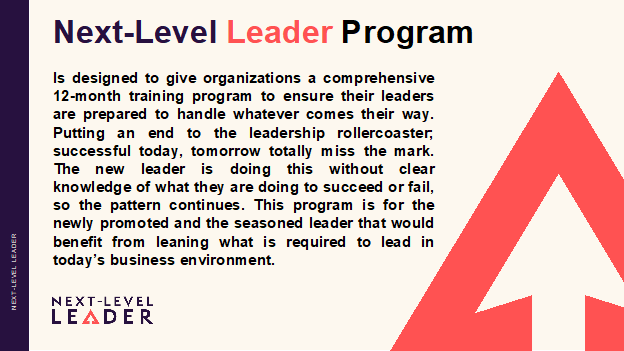
Future leaders will be compassionate and strong and care about the person and the product, employee well-being, and the bottom line.
With the ability to turn a difficult conversation into a productive, constructive, transformational experience.
Who identify and nurture each direct report to reach their highest level of success and value for the company.
Developing diverse teams with a wealth of varying experience to identify the most robust and innovative solutions. Along with the next big breakthrough idea that has you seen as a leader in your industry.
Leaders like this exist today, and with programs like Next-Level Leader, there will be many more to follow.
Here is a truth about what a leader is today.
We don’t look the same or have the same level or type of experience. However, we can all arrive at the same destination anyway. The key is to recognize the benefits of different leadership styles and use them to improve the company, culture, and morale.
To achieve this leadership quality, you must start at the beginning. Building the leader from the inside out. When you compete for your success, it is yours today and someone else’s tomorrow. When you build your success from within, no one can take that from you.
By uncovering their innate leadership style and the impact that style offers, you have just created the foundation upon which this leader will stand. Their decisions will be clearer, easier, and more consistent. This is a huge benefit for the company and its departments or teams. There will be no question about their full value and how that will impact the company going forward.
When you commit to giving your leaders all they need to be the success you need them to be, you create a company culture that says I care about you, the employee, AND the bottom line. Ultimately, this creates the type of leader people will line up at the door to work with, and the company people want to buy from.
Curriculum
Next-Level Leader – Part 1 – Year 1
- Part 1 Month 1 Assessment Benchmark
- Part 1 Month 2 Leadership Impact
- Part 1 Month 3 Next-Level Identity
- Part 1 Month 4 Essential Skills
- Part 1 Month 5 Masterful Communication
- Part 1 Month 6 Presence, Presentation
- Part 1 Month 7 Purposeful Leadership
- Part 1 Month 8 Team Excellence
- Part 1 Month 9 Companywide Collaboration
- Part 1 Month 10 Growth Mindset
- Part 1 Month 11 Internal Networking
- Part 1 Month 12 Emboldened Action
Program Objectives
The following list represents the Key Program Objectives (KPO) for the Appleton Greene Next-Level Leader corporate training program.
Next-Level Leader – Part 1 – Year 1

Part 1 Month 1: Assessment, Benchmark
The program commences with the Next-Level Leader Assessment, pinpointing participants’ strengths and developmental areas while fostering self-awareness of their leadership position. It establishes a benchmark for progress measurement upon program completion. Participants are oriented to program objectives, emphasizing an open, curious, and fully present mindset, prioritizing active listening, confidentiality, and a judgment-free zone.
There will be group discussions on the assessment findings, encouraging participants to share openly and learn from others as well. Leadership competencies are explored using the Next-Level Leader assessment and the SWOT framework (Strengths, Weaknesses, Opportunities, Threats), providing insight into today’s leadership landscape.
Participants also identify challenges, draw inspiration from admired leaders, and devise solutions, fostering problem-solving skills and deeper leadership understanding.
Moreover, participants review the top 10 challenges newly promoted leaders experience, equipping them with strategies to navigate potential obstacles effectively.
The program offers a holistic approach to leadership development, integrating self-assessment, benchmarking, and targeted skill enhancement. Through introspection, dialogue, and practical exercises, participants emerge equipped with insights and tools necessary for success as next-level leaders.
Part 1 Month 2: Leadership Impact
Leadership development hinges on understanding one’s unique style, a process facilitated by the Values Catalyst Indicator. This proprietary tool delves into leaders’ core non-negotiable values, illuminating the essence of their leadership approach. It transcends mere resume details, urging individuals to embrace the full breadth of their capabilities.
Participants explore the rich tapestry of leadership styles, emphasizing authenticity and self-awareness. Through introspection and collaboration, leaders pinpoint their core non-negotiable values, shaping their actions and decisions. They learn to articulate the impact of their style, identifying natural problem-solving abilities and unique value propositions. The focus isn’t on conformity but on honoring individuality, leveraging distinct styles for maximum effect.
This journey isn’t passive; it’s a call to action. Leaders translate their core non-negotiable values into tangible business outcomes. Through exercises and exploration, they refine their approach, ensuring authenticity and a positive impact on the participant’s leadership endeavors.
In a competitive corporate landscape, differentiation is vital. Leaders equipped with self-awareness and a clear value framework stand out. They’re not followers but trailblazers, guided by principles and propelled by strengths.
By investing in this journey, organizations empower their leaders. They position individuals where their impact is greatest, fostering a culture of growth and innovation. It’s a transformative journey rooted in values and poised to reshape the leadership landscape.

Part 1 Month 3: Next-Level Identity
One’s leadership identity is a complex amalgamation of various components that collectively define how one leads, influences others, and navigates the challenges of leadership. At its core lie the individual’s values and beliefs, serving as guiding principles that shape their decision-making process and overall behavior. Additionally, a clear vision and sense of purpose provide direction and inspiration, enabling leaders to articulate their goals and motivate others to work towards common objectives.
Personality traits play a significant role in shaping a leader’s style and effectiveness. Traits such as emotional intelligence, communication skills, adaptability, and resilience influence how leaders interact with their teams, stakeholders, and the broader organizational environment. Leaders with high emotional intelligence are adept at understanding and managing their own emotions and those of others, fostering trust, collaboration, and effective relationships within their teams.
Furthermore, past experiences, both personal and professional, contribute significantly to the development of a leader’s identity. Each success, failure, and lesson learned shapes their perspective, approach, and resilience in facing challenges. These experiences are valuable learning opportunities, providing insights into effective leadership practices and strategies for overcoming obstacles.
Cultural and social context also play a crucial role in shaping a leader’s identity. Leaders must be cognizant of cultural differences and societal norms, adapting their leadership approach to foster inclusivity, diversity, and mutual respect within their teams and organizations. Effective leaders recognize the importance of embracing diversity and leveraging the unique strengths and perspectives of individuals from different backgrounds.
Continuous learning, feedback, and self-reflection are fundamental for leaders committed to personal and professional growth. By seeking feedback from peers, mentors, and team members, leaders can gain valuable insights into their strengths and areas for improvement.
Additionally, engaging in regular self-reflection allows leaders to evaluate their performance, refine their leadership style, and identify opportunities for further development.
In summary, one’s leadership identity is a dynamic and multifaceted construct that evolves through a combination of personal characteristics, experiences, roles we played growing up, what we learned living through adversity, and ongoing learning. By embracing their values, leveraging their strengths, and fostering a culture of inclusivity and continuous improvement, leaders can cultivate a strong and authentic leadership identity that inspires and empowers others.
Part 1 Month 4: Essential Skills
In today’s dynamic environment, successful leadership demands more than just technical expertise; it requires a profound understanding of essential skills that transcend traditional notions of leadership. This shift signifies a move towards caring for the whole person, acknowledging individual career aspirations, and creating avenues for personal growth within organizational settings. Consequently, contemporary leaders must navigate an evolving landscape of rapid change and uncertainty.
Emotional intelligence (EI) is central to effective leadership, which enables leaders to understand and manage their emotions while fostering positive relationships. Self-awareness is a cornerstone of EI, empowering leaders to objectively assess their strengths and areas of development. Through self-assessment activities and targeted interventions, leaders can enhance their emotional intelligence, ultimately influencing their success.
Adaptability and agility emerge as indispensable traits in this context, enabling leaders to navigate complex challenges with resilience and creativity. Recognizing the interconnectedness between self-awareness, emotional intelligence, and adaptability, leaders can cultivate a holistic approach to leadership development.
Integrating these concepts into training sessions provides participants with a comprehensive toolkit for leadership success. By offering practical strategies for application in professional roles, training programs empower individuals to bridge the gap between theory and practice.
The Essential Skills Lab is a crucial platform for participants to translate theoretical knowledge into real-world scenarios. Through immersive experiences and hands-on activities, participants can refine their leadership skills and gain valuable insights into their application within diverse contexts. Fostering a continuous learning and development culture ensures leaders are equipped to thrive in today’s ever-evolving landscape.

Part 1 Month 5: Masterful Communication
Effective communication is a cornerstone of successful leadership, yet it’s an area where many new and seasoned leaders struggle. Mastering communication protocols in today’s business environment is essential to excel in higher-level roles.
Technology has allowed us to connect with people and resources around the globe that we would not have had access to without it. However, it has killed our ability to actually communicate with one another by creating walls for us to hide behind.
In this interactive session, participants will bring specific types of communication that they are challenged by. These areas will be woven into the live training of the 12 Principles of Masterful Communication.
This session offers a comprehensive curriculum covering essential aspects of effective leadership communication. Such as the various types of leader-to-direct reports conversations, leader vs manager, difficult conversations, productive feedback, peer-to-peer, and leader-to-higher levels of authority.
We also explore what needs to change when communicating the same message to different people or presentations to different groups. The key is to be heard, and it is not possible to achieve this if the differences in who you are speaking to and the where and when of the conversations or presentations are not factored in.
Understanding the role of perception in leadership and mastering proactive response strategies are also key components of the program. Furthermore, participants will explore the significance of communication in leadership roles and its direct impact on organizational success. Through discussions on various leadership styles and communication approaches, attendees will gain insights into tailoring their interactions to different scenarios. Practical application is emphasized through a Communication Lab, providing a supportive setting for participants to practice newly acquired skills. From building trust and credibility to navigating difficult conversations and leading through change, this program equips leaders with the tools necessary to excel in higher-level roles.
In conclusion, mastering communication in leadership is an ongoing journey. By honing these skills, leaders can navigate challenges, inspire their teams, and drive organizational success in today’s complex business landscape.
Part 1 Month 6: Presence, Presentation
In this training session, we’ll embark on a journey to develop executive presence and master the art of effective presentations. We’ll kick off by focusing on cultivating executive presence. Through a self-assessment exercise, participants will gain insight into their current level of executive presence, enabling them to identify areas for growth. We’ll then explore the fundamental components of executive presence, including confidence, communication skills, gravitas, and authenticity. Practical strategies will be provided to enhance their executive presence, encompassing aspects such as body language, voice modulation, professional image, and emotional intelligence.
Transitioning to the realm of presentation skills mastery, we’ll delve into the intricacies of delivering impactful presentations. Understanding the importance of setting clear objectives and effectively structuring presentations. Various delivery techniques will be discussed, including vocal delivery, body language, eye contact, and strategies for managing nervousness and anxiety. Additionally, we’ll delve into the art of designing visually compelling slides and utilizing visual aids to enhance audience understanding while avoiding information overload. Participants have ample opportunities to hone their presentation skills in a supportive environment through interactive activities such as role-plays, peer feedback sessions, and elevator pitch practice.
As we explore the application of executive presence in presentations, we’ll analyze real-world examples of presentations delivered with strong executive presence. Engaging in role-playing exercises, Participants have the chance to integrate the principles of executive presence into their own presentations. Constructive feedback and peer discussions will further refine their approach, culminating in creating a personalized action plan outlining steps to apply executive presence in future presentations.
In conclusion, we’ll recap the key insights gained throughout the training and address any lingering questions or concerns in a dedicated Q&A session. With emphasis on the importance of continual practice and refinement in both executive presence and presentation skills.

Part 1 Month 7: Purposeful Leadership
Leading with purpose in today’s business landscape involves steering organizations with a clear vision that transcends mere financial success. It entails aligning business objectives with a deeper sense of meaning and societal impact, acknowledging the interconnectedness of businesses with the broader world. To effectively lead with purpose, several fundamental elements must be embraced.
Firstly, leaders must define and communicate a compelling vision and mission that encapsulates the organization’s purpose. This vision serves as a guiding light, shaping strategic decisions and providing a sense of direction for all stakeholders. Additionally, authenticity and transparency are crucial in purpose-driven leadership. Leaders must authentically embody the organization’s values and principles, fostering trust and credibility among employees, customers, and the community.
Furthermore, purpose-driven leaders prioritize employee engagement and empowerment. They recognize the importance of creating a supportive work environment where employees feel valued, motivated, and encouraged to contribute meaningfully. Leaders can harness diverse perspectives and talents to drive innovation and achieve organizational goals by empowering their teams.
Collaboration with stakeholders is another essential aspect of leading with purpose. Purpose-driven leaders actively engage with a broad range of stakeholders, including employees, customers, suppliers, and the local community. By fostering open dialogue and partnerships, leaders can better understand the needs and expectations of stakeholders, driving collective efforts towards shared objectives.
Ethical leadership is also fundamental to purpose-driven leadership. Leaders must uphold high ethical standards, demonstrating integrity, fairness, and accountability in their decision-making processes. By prioritizing ethical conduct, leaders can build trust and foster a culture of integrity within the organization.
Leading with purpose requires a holistic approach that integrates vision, authenticity, collaboration, ethics, and sustainability. By embracing these elements, leaders can inspire and motivate their teams, drive organizational success, and make a meaningful impact in today’s ever-evolving business world.
Part 1 Month 8: Team Excellence
Team excellence is the collective of various essential elements that intertwine to create a robust and high-performing team dynamic. At its core lies the connection with the team members, understanding of each member’s strengths, areas of development, and desired career path, and a shared clarity on goals and objectives, providing the team with a unified sense of purpose and direction. Effective leadership reinforces and guides this clarity, providing vision and direction while fostering trust, respect, and collaboration among team members. Leadership sets the tone for communication within the team, emphasizing openness, transparency, and active listening, facilitating the exchange of ideas, feedback, and information crucial for informed decision-making and problem-solving. It is also an opportunity to identify where individual team members can shine and take that next step in their growth and development. Ultimately playing to the diverse strengths of their team. And creating high-performing teams and individual centers of excellence.
Trust is a foundational element of team excellence, enabling individuals to rely on one another’s abilities, intentions, and integrity. It fosters a sense of psychological safety within the team, encouraging risk-taking, innovation, and constructive conflict resolution. Collaboration and teamwork leverage team members’ diverse strengths, skills, and perspectives, promoting synergy and creativity in pursuing shared goals. Each team member’s accountability for their responsibilities and commitments reinforces reliability and integrity, ensuring that the team functions cohesively and achieves its objectives.
Continuous learning and improvement are integral to sustaining team excellence and fostering a culture of growth, adaptability, and resilience. Diversity and inclusion enrich team dynamics, bringing forth a breadth of ideas, experiences, and viewpoints that drive innovation and effectiveness. Adaptability and flexibility enable teams to navigate changing circumstances, seize opportunities, and overcome challenges with agility and resilience. Recognition and celebration of achievements, milestones, and contributions bolster morale, motivation, and a shared sense of accomplishment, reinforcing positive behaviors and fostering a strong sense of camaraderie and belonging within the team. By nurturing these elements, organizations can cultivate an environment where teams excel, thrive, innovate, and achieve remarkable results.

Part 1 Month 9: Companywide Collaboration
This training focuses on, Fostering Companywide Collaboration: Building Stronger Teams Together,” which sets the tone for this training, emphasizing the collective effort needed to enhance collaboration within the organization. The objectives outlined encompass understanding the significance of collaboration, developing communication skills, learning tools and techniques, and cultivating a collaborative culture.
The agenda is divided into four sessions, each dedicated to specific aspects of collaboration. Session 1 serves as an introduction, highlighting the importance of collaboration through interactive activities, case studies, and discussions on challenges. Session 2 focuses on communication skills, including active listening, assertiveness, and nonverbal communication, with practical exercises to reinforce learning. Session 3 delves into tools and techniques, covering collaboration tools, virtual collaboration best practices, and hands-on practice sessions. Session 4 explores building a collaborative culture involving leadership’s role, recognition and rewards, team-building activities, and strategies to overcome resistance.
Whether their team struggles with remote collaboration, communication barriers, or resistance to change, our training provides practical solutions and actionable strategies to overcome these challenges. With a focus on peer learning and open discussion, participants can share experiences, gain insights, and build connections with colleagues.
In conclusion, the training includes a recap of key learning points, action planning for personal and team goals, and feedback collection. Additional considerations such as incorporating interactive activities, encouraging open discussion, providing resources, and following up with reinforcement activities are essential to enhancing engagement and ensuring the sustainability of learning outcomes.
Part 1 Month 10: Growth Mindset
The core component, Understanding Growth Mindset, explains the concept of growth versus fixed mindsets and outlines key characteristics associated with the former. It highlights the benefits of adopting a growth mindset in leadership, emphasizing enhanced effectiveness.
Self-assessment and reflection prompt participants to reflect on their mindset tendencies, followed by group discussions for shared insights and mutual learning.
Developing a Growth Mindset offers strategies for cultivating such a mindset and overcoming common fixed mindset triggers. Real-life examples of leaders exhibiting growth mindsets are analyzed.
Growth Mindset in Leadership explores how leaders can embody and promote growth mindsets within their teams. Effective feedback and coaching methods conducive to a growth mindset culture are discussed, alongside strategies for handling challenges and setbacks.
In the Application and Action Planning phase, participants create action plans tailored to their leadership roles, with encouragement for accountability partnerships to support mutual learning and growth.
Through varied learning modalities, including presentations, discussions, self-assessment, and action planning, this training equips participants with knowledge and tools to integrate growth mindset principles into their leadership practices, fostering resilience and continuous improvement.

Part 1 Month 11: Internal Networking
This module is tailored to professionals who have recently received significant promotions within their organizations. At the heart of this training lies the recognition of the pivotal role that internal networking plays in continuing to shape their career trajectories and organizational success.
Beginning with a comprehensive understanding of internal networking, starting with an in-depth exploration of its definition, benefits, and distinctions from external networking efforts. Participants will learn effective communication techniques, trust-building strategies, and how to navigate potential barriers to relationship-building, equipping them with the tools needed to forge genuine connections that transcend organizational boundaries.
We’ll explore how to build relationships across departments and hierarchical levels, creating synergies that drive the organization’s productivity and creativity. The ability to bridge silos, facilitate communication, and cultivate a culture of mutual support and respect can have a ripple effect throughout the organization, leading to increased employee engagement, retention, and overall organizational success.
In essence, the participant’s commitment to internal networking isn’t just about advancing their career—it’s about contributing to the company’s collective success. By actively engaging with colleagues, seeking out opportunities to collaborate, and leveraging their network to drive positive change, they will elevate their professional standing and help create a more cohesive, innovative, and resilient organization.
Part 1 Month 12: Emboldened Action
In our first module, we embarked on a journey of growth and development as newly promoted leaders. We established benchmarks, clarified roles, and envisioned the path ahead. As we arrive at the culmination of our 12-month program, it’s time to celebrate the remarkable progress and chart a course for continued success.
During this closing session, we will take a moment to reflect on the journey participants have undertaken together. We’ll revisit the benchmarks set in Module One, recognizing the significant strides each participant has made since then. Through individual reflections and group discussions, we’ll celebrate accomplishments, acknowledging the dedication, resilience, and growth demonstrated by all.
Building upon this foundation of achievement, we will then transition into the heart of our final module: crafting an emboldened action plan. Drawing upon the insights gained throughout the program, participants will identify their key strengths, areas for further development, and aspirations for the future. With clarity and confidence, they will set ambitious yet achievable goals using the SMART criteria—specific, measurable, achievable, relevant, and time-bound.
Moreover, this module will provide a platform for participants to share their visions and strategies with their peers. They will refine their action plans through collaborative discussions and feedback sessions, leveraging collective wisdom and diverse perspectives to enhance their effectiveness. This collaborative process fosters camaraderie and strengthens each participant’s resolve to pursue their goals with renewed determination.
As we conclude the program, we will emphasize the importance of accountability and support in sustaining momentum beyond the training room. Participants will outline strategies for overcoming challenges and staying committed to their action plans, identifying resources and networks to aid them in their journey.
Our final module is a testament to the transformative power of effective leadership development. Through reflection, celebration, and strategic planning, we will honor the progress while laying the groundwork for a future defined by bold action and sustained growth.
Methodology
Next-Level Leader
The Next-Level Leader program is designed to give organizations a comprehensive 12-month training program to ensure their leaders are prepared to handle whatever comes their way. Putting an end to the leadership rollercoaster of success today and tomorrow totally misses the mark. The new leader is doing this without clear knowledge of what they are doing to succeed or fail, so the pattern continues. This is true for the newly promoted and for the seasoned leader who would benefit from understanding all that is required to be a highly regarded and respected leader in business today.
Sustainable success of any kind begins within and must include the development of the whole person rather than one aspect of leadership. It is also imperative that your leaders are not striving to be a clone of another leader rather than developing their individual leadership style.
There are six pillars and twelve areas of focus in our proven methodology that develop well-rounded, highly recognized, and respected leaders who are prepared to lead successfully in today’s business environment.
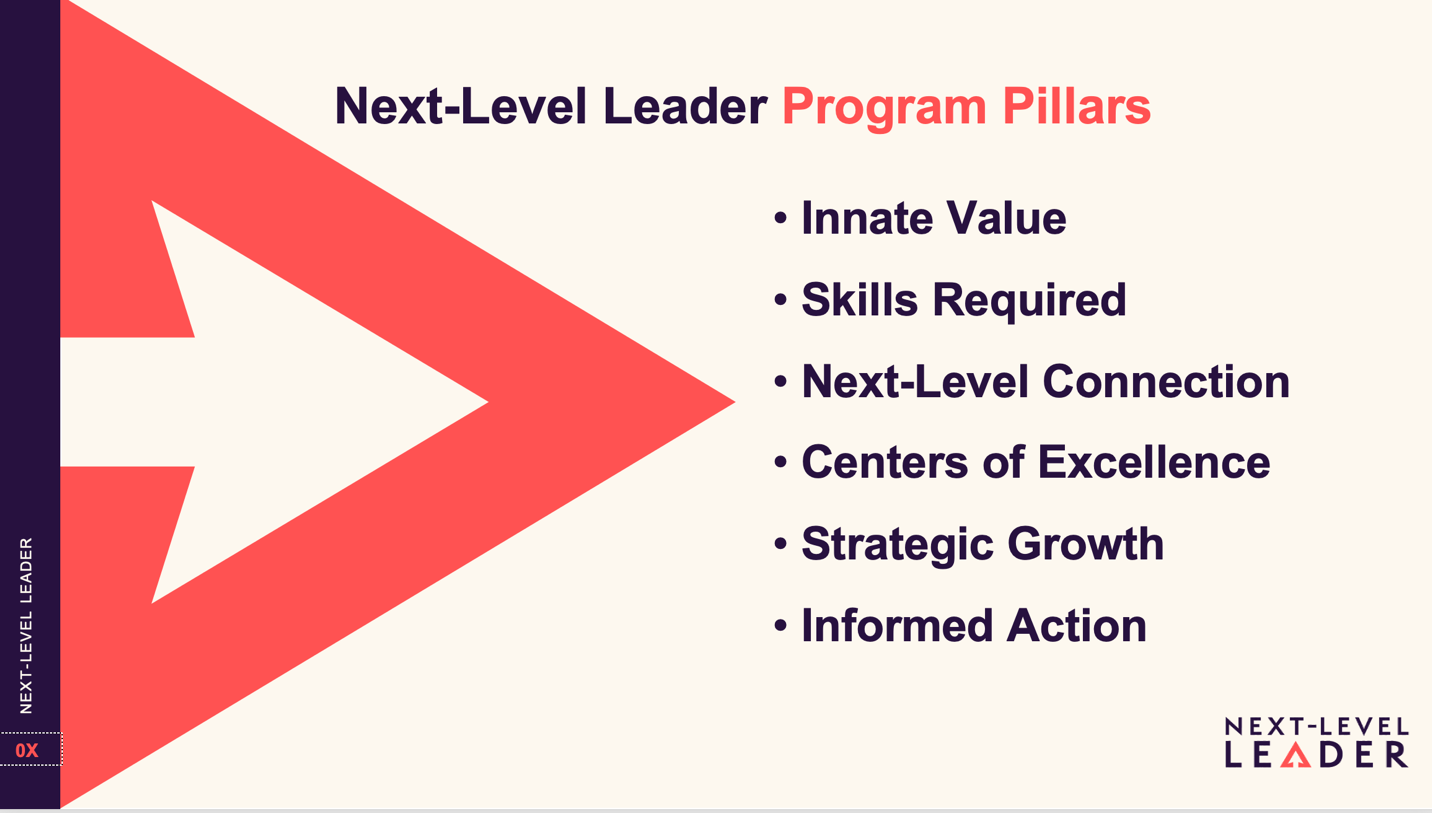
Pillar #1: Innate Value
Innate Value and Leadership Impact
Beginning with the Next-Level Leader leadership assessment. Creating a benchmark that will be referenced throughout and reviewed upon program completion. Followed by the exploration and identification of their individual leadership style. This process also articulates the impact of their unique leadership on their position, company, department, or team. Helping them recognize and own the full value of what they have to offer rather than just what’s on their resume. This will also differentiate them from other leaders in the company and build out a diverse leadership team with complementary and individual areas of strength.
Pillar #2: Skills Required
Next-Level Identity and Essential Skills
One’s leadership identity is a dynamic and multifaceted construct that evolves through a combination of personal characteristics, experiences, roles we played growing up, what we learned while living through adversity, and ongoing learning.
Participants will bring what they learned about their individual leadership style and begin to articulate their Next-Level Identity. Moving directly into understanding the skills required to be successful in their new role. Keeping in mind that what may have been considered a soft skill in the past is now recognized as essential.
Your leaders will recognize the importance of a particular skill or their leadership identity, and have the time and space to practice it firsthand through this Pillars Leadership Lab.
Pillar #3: Next-Level Connection
Masterful Communication and Presence, Presentation
The training breaks down the various types of communication required for leaders today. Covering: overall communication principles, leader to direct report, colleague to colleague, leader to upper management, productive feedback, and how to handle difficult conversations. Each leader in the program will bring a type(s) of communication that is a challenge for them, which will be incorporated into the training and give them an opportunity to get firsthand experience in the Communication Lab. Another form of communication is presence and presentation. This includes their personal executive presence (incorporating their leadership style and position/role in the company) and presentation excellence in person and online.
Phase #4: Centers of Excellence
Purposeful Leadership and Team Excellence
Purposeful leadership is not so much about where you work; it is about what you bring to your work. Helping your team see their work’s impact on the company’s bigger picture. Building strong, cohesive, diverse, and innovative teams with complementary and individual experiences/talents and the role purposeful leadership plays in making that happen. Training covers the 6 Steps to Building Meaningful Connections with Direct Reports, The Essential Elements of Creating and Maintaining Transformative Teams, and Purposeful Leadership.
Phase #5: Strategic Growth
Companywide Collaboration and Growth Mindset
Yesterday’s solution cannot resolve today’s challenges, problems, and opportunities. Hence, the importance of companywide collaboration. When done correctly, it fosters trust, a safe space where all ideas are welcome, transparency, connections, understanding of the work in different departments, robust solutions, innovations, and so on. A growth mindset is key to being/remaining relevant, increasing your value to the company, and being seen as a forward-thinking leader. We identify areas of change and growth in their position, company, and industry and develop steps to address them.
Phase #6: Informed Action
Internal Networking and Emboldened Action
There are many different types of networking. This pillar allows your leaders to gather all they have learned during this program, identify areas for knowledge sharing, improve communication, deepen relationships, and design an approach to network this internally. In the final month of the program, they will re-take the Next-Level Leader assessment and compare it to their original assessment. Noting their growth and the impact, they now offer the company with deeper levels of confidence. With this new level of clarity, your leaders will develop an emboldened action plan to continue to evolve as leaders and increase their value and responsibilities in the company.
Industries
This service is primarily available to the following industry sectors:
Advertising
Advertising has undergone a monumental evolution, largely catalyzed by technological advancements and changing consumer behaviors. Digital advertising has emerged as the primary driver of this transformation, overshadowing traditional channels like television, print, and radio. The ubiquity of smartphones and the proliferation of social media platforms have fueled this shift, prompting advertisers to redirect their focus toward digital avenues to reach their target audiences effectively.
The mobile revolution has played a pivotal role in digital advertising. With more people accessing the internet through mobile devices than ever before, advertisers have had to adapt their strategies to cater to the preferences of on-the-go consumers. This has led to the development of mobile-friendly content and targeted advertising campaigns tailored specifically for mobile platforms, optimizing for smaller screens and shorter attention spans.
Moreover, the rise of big data analytics and artificial intelligence has revolutionized advertising practices, enabling advertisers to leverage user data for precise audience targeting and personalized messaging. This data-driven approach has empowered advertisers to deliver highly relevant ads to specific demographics, enhancing engagement and ROI. However, it has also sparked concerns about privacy and data security, prompting the implementation of stricter regulations such as the GDPR and CCPA, which have compelled advertisers to prioritize transparency and user consent in their advertising practices.
In response to the growing challenge of ad blockers and consumer aversion to intrusive advertising, brands have shifted towards creating more immersive and non-disruptive ad experiences. Video advertising has gained significant traction, driven by the popularity of platforms like YouTube and the emergence of short-form video content on platforms like TikTok. Additionally, influencer marketing has emerged as a powerful strategy for brands to connect with audiences through trusted personalities on social media, leveraging their influence and credibility to drive engagement and brand awareness.
Furthermore, the integration of advertising with e-commerce has reshaped the consumer journey, allowing consumers to shop directly from ads on platforms like Facebook and Instagram. This convergence of advertising and commerce has blurred the lines between discovery and transaction, creating new opportunities for brands to engage with consumers throughout their purchase journey. As new advertising platforms continue to emerge and consumer preferences evolve, advertisers must remain agile and innovative, constantly adapting their strategies to stay relevant in an increasingly competitive and dynamic landscape.
Media & Entertainment
Over the past decade, the media and entertainment industry has undergone a seismic shift, largely propelled by technological advancements and evolving consumer behaviors. The proliferation of high-speed internet and the widespread adoption of smartphones have fundamentally altered how people consume media. Streaming platforms have emerged as dominant players, disrupting traditional distribution channels and ushering in an era of on-demand entertainment. This shift has been exemplified by the rise of Netflix, Amazon Prime Video, and other streaming services, which have not only challenged the dominance of cable and broadcast television but have also transformed the way content is produced and consumed.
One of the most notable trends of the past decade has been the explosion of original content production. Streaming platforms have invested billions of dollars in creating high-quality original programming, ranging from scripted dramas and comedies to documentaries and reality shows. This has led to a renaissance in television, with audiences enjoying a diverse array of content across various genres. Additionally, the democratization of content creation has empowered individuals to produce and distribute their own videos, music, and other forms of media through platforms like YouTube and TikTok, further expanding the landscape of entertainment.
However, this era of digital disruption has not been without its challenges for traditional media outlets. Newspapers, magazines, and broadcast networks have faced declining revenues and audiences as advertising dollars have shifted online. Many legacy media companies have struggled to adapt to the new digital landscape, leading to layoffs, consolidation, and in some cases, closures. In addition, there are concerns about misinformation, content moderation, and data privacy that have prompted calls for increased regulation and oversight of digital platforms. Regulatory scrutiny will increase, necessitating compliance with stricter regulations. The industry will need to maintain the prioritization of sustainability, diversity, equity, and inclusion. As the industry continues to evolve, companies will need to embrace innovation, adapt to changing consumer preferences, and navigate regulatory challenges to thrive in the dynamic media and entertainment landscape of the 21st century.
Technology
The technology industry continues to experience profound transformation, propelled by groundbreaking innovations and societal shifts. Artificial intelligence (AI) emerged as a central driving force, with advancements in machine learning and natural language processing revolutionizing how humans interact with technology. AI-powered virtual assistants like Siri and Alexa became ubiquitous, while industries across the board integrated AI-driven automation to streamline operations and enhance productivity. However, alongside the promise of AI came concerns about privacy, ethics, and the potential for job displacement, prompting calls for responsible AI development and regulation.
Concurrently, the Internet of Things (IoT) witnessed explosive growth, with an array of connected devices permeating various aspects of daily life. From smart homes and wearables to industrial sensors and autonomous vehicles, the IoT ecosystem expanded rapidly, generating vast amounts of data and enabling unprecedented insights and automation. Yet, the proliferation of IoT devices also raised significant challenges related to data security, interoperability, and privacy, underscoring the need for robust standards and protocols to ensure the integrity and resilience of interconnected systems.
The deployment of 5G networks emerged as a transformative milestone, promising unparalleled speed, bandwidth, and low latency for wireless communication. This next-generation connectivity facilitated innovations in areas like augmented reality (AR), autonomous vehicles, and remote healthcare, unlocking new possibilities for economic growth and societal advancement. However, the rollout of 5G also sparked debates over infrastructure investment, spectrum allocation, and potential health and environmental impacts, highlighting the complex interplay between technological progress and societal concerns.
Throughout the decade, cybersecurity remained a pressing issue, with cyber threats evolving in sophistication and scale. High-profile data breaches, ransomware attacks, and state-sponsored cyber espionage incidents underscored the critical importance of robust cybersecurity measures and international cooperation in safeguarding digital infrastructure. Meanwhile, growing awareness of environmental sustainability prompted increased focus on green technologies, renewable energy sources, and ethical considerations in technology development, signaling a broader societal shift towards responsible innovation and digital stewardship.
Fast-Moving Consumer Goods
The Fast-Moving Consumer Goods (FMCG) industry has undergone seismic transformations, propelled by evolving consumer preferences, technological advancements, and shifting market dynamics. E-commerce has emerged as a dominant force, revolutionizing the retail landscape and redefining how consumers interact with FMCG products. The convenience and accessibility of online shopping have prompted FMCG companies to bolster their digital presence, optimize supply chains, and innovate in areas such as last-mile delivery to meet the demands of a digital-savvy consumer base.
Health and wellness have become paramount considerations for consumers, driving a surge in demand for healthier food and beverage options. In response, FMCG companies have introduced organic, natural, and functional products, reflecting a broader societal trend towards well-being and sustainability. Consequently, sustainability has risen to the forefront of industry priorities, with companies investing in eco-friendly packaging, responsible sourcing practices, and transparency initiatives to mitigate their environmental footprint.
Personalization and customization have emerged as key strategies for FMCG companies seeking to enhance consumer engagement and loyalty. Leveraging technology, companies are offering personalized nutrition plans, customizable beauty products, and tailored subscription services catering to individual preferences and lifestyles. Concurrently, digital marketing has become indispensable for FMCG brands, with social media, influencer partnerships, and targeted advertising campaigns serving as vital channels for connecting with consumers in a competitive marketplace.
The rise of private labels has reshaped the FMCG landscape, with retailers expanding their offerings to provide affordable alternatives to national brands. This trend has prompted FMCG companies to fortify their brand equity through innovation, differentiation, and value propositions. Despite facing regulatory challenges, supply chain disruptions, and global uncertainties, the FMCG industry has demonstrated resilience and adaptability, positioning itself for continued growth and competitiveness in the years ahead.

Hospitality
The hospitality industry has undergone significant transformation driven by technological advancements, shifting consumer preferences, and global trends. One of the most notable changes has been the integration of technology into various facets of hospitality services. Mobile apps for bookings, keyless entry systems, and data analytics for personalized guest experiences have become commonplace, enhancing efficiency and convenience for both guests and hoteliers alike.
The rise of the sharing economy, epitomized by platforms like Airbnb and Verbo, has disrupted traditional hotel models. Travelers now have access to a wide array of alternative accommodations, from private homes to boutique rentals, challenging established hospitality norms and prompting hotels to innovate to remain competitive. This trend has not only diversified lodging options but also empowered individuals to participate in the hospitality sector as hosts, further reshaping the industry landscape.
Sustainability has emerged as a key focus area within the hospitality sector over the past decade. With growing environmental awareness, hotels and resorts are implementing eco-friendly practices such as energy conservation, waste reduction, and sustainable sourcing of materials. Guests increasingly expect responsible business practices from hospitality providers, driving the adoption of green initiatives and certification programs aimed at minimizing the industry’s environmental footprint.
Personalization has become a cornerstone of modern hospitality, fueled by advancements in data analytics and artificial intelligence. Hotels are leveraging guest data to offer tailored recommendations, personalized amenities, and bespoke experiences, enhancing guest satisfaction and loyalty. This shift towards individualized service reflects a broader trend of consumer demand for unique and memorable experiences, driving hotels to differentiate themselves through personalized offerings.
Despite these advancements, the hospitality industry has faced unprecedented challenges, most notably the COVID-19 pandemic. The pandemic brought travel to a standstill, resulting in widespread closures, layoffs, and financial strain for many hospitality businesses. However, it also catalyzed innovation and adaptation, accelerating trends such as contactless services, remote work-friendly accommodations, and enhanced health and safety protocols. As the industry continues to recover and rebuild, resilience, flexibility, and a renewed focus on guest well-being will remain paramount in shaping its future trajectory.
Locations
This service is primarily available within the following locations:

New York
New York City (NYC) is a multifaceted metropolis renowned for its iconic landmarks and thriving business landscape. From the majestic Statue of Liberty, standing as a beacon of freedom and democracy on Liberty Island, to the dazzling lights of Times Square, known as “The Crossroads of the World,” NYC captivates visitors with its vibrant energy and cultural richness. Central Park offers a serene escape amidst the city’s skyscrapers, while Broadway’s renowned theaters host some of the world’s most acclaimed shows and musicals, drawing theater enthusiasts from around the globe.
In addition to its cultural allure, NYC is a global financial hub, with Wall Street at its helm. The New York Stock Exchange and NASDAQ, among others, make NYC a vital center of global finance, while investment banks, hedge funds, and asset management firms contribute to its economic prowess. The city’s media and entertainment industry is equally influential, with major conglomerates headquartered there and Broadway serving as the epicenter of American theater.
Furthermore, NYC has emerged as a thriving hub for technology and innovation, attracting startups, tech giants, and venture capital investment. The city’s tech ecosystem, known as Silicon Alley, drives industries such as digital media, e-commerce, fintech, and biotech, contributing to its reputation as a center for entrepreneurship and innovation. Meanwhile, the real estate market, characterized by iconic skyscrapers and historic brownstones, remains one of the most lucrative and competitive in the world, with real estate development, investment, and brokerage playing major roles in the city’s economy.
NYC’s hospitality and tourism industry draws millions of visitors each year to its iconic landmarks, cultural attractions, and vibrant culinary scene, while the city’s fashion district and healthcare sector further bolster its global influence. With world-class medical institutions, research centers, and biotech companies, NYC leads in healthcare and life sciences innovation, while professional services such as law, accounting, consulting, and advertising thrive in its bustling streets.
These industries and sectors collectively contribute to NYC’s status as a leading global business hub, attracting talent, investment, and opportunities from around the world. Whether marveling at its iconic landmarks or engaging with its dynamic business landscape, New York City offers a wealth of experiences and opportunities that embody the essence of urban vitality and innovation.

Los Angeles
Los Angeles, often hailed as the entertainment capital of the world, is renowned for its vibrant cultural scene, iconic landmarks, and diverse population. At the heart of its fame lies Hollywood, a district synonymous with the film industry, home to major studios, celebrities, and the legendary Hollywood Sign. The city’s coastline boasts picturesque beaches like Santa Monica and Venice Beach, drawing locals and tourists alike for sun-soaked relaxation and water sports.
Beyond its shores, LA embraces a rich tapestry of cultures, reflected in its diverse neighborhoods, culinary offerings, and vibrant arts scene. From the historic Olvera Street in Downtown LA to the bustling streets of Koreatown and Little Tokyo, the city pulses with the energy of different communities. Visitors can explore world-class museums like the Getty Center and LACMA, showcasing art from around the globe, or immerse themselves in the creativity of local galleries and street art.
Moreover, Los Angeles is not just a city of glitz and glamour but also a hub for innovation and technology. Silicon Beach has emerged as a prominent tech hub in recent years. The city’s dynamic economy spans various sectors, including entertainment, aerospace, fashion, and healthcare. Meanwhile, its diverse culinary landscape offers a tantalizing array of flavors, from gourmet food trucks to Michelin-starred restaurants, catering to every palate.
Coupled with its Mediterranean climate, characterized by mild winters and sunny days, LA provides an inviting backdrop for exploration and enjoyment, making it a destination that captivates the imagination of millions around the globe. Whether strolling along the Hollywood Walk of Fame, catching a concert at the Hollywood Bowl, or hiking in the scenic hills of Griffith Park, Los Angeles offers endless possibilities for adventure and discovery.

Washington, D.C.
Washington, D.C., the revered capital of the United States, embodies a unique blend of political significance, historical grandeur, and economic vitality. As the seat of the nation’s government, the city is adorned with iconic landmarks that symbolize American democracy and heritage. The White House, the residence of the President, and the U.S. Capitol, home to the Congress, stand as enduring symbols of political power and governance.
The National Mall, stretching majestically from the Capitol to the Lincoln Memorial, is a tribute to the nation’s history. It is adorned with monuments such as the Washington Monument, the Lincoln Memorial, the Jefferson Memorial, and the Vietnam Veterans Memorial. This expansive parkland attracts millions of visitors annually, offering a poignant reflection on America’s past and its enduring values.
Beyond its historical and political significance, Washington, D.C., is a thriving economic hub characterized by diverse industries and vibrant business sectors. Government contracting flourishes due to the city’s status as the nation’s capital, with countless businesses providing goods and services to federal agencies. Professional service firms, including law, consulting, and accounting, cater to the unique needs of government clients, navigating regulatory frameworks and shaping public policy.
Trade associations and advocacy groups proliferate in the city, exerting influence on legislation and public discourse. The financial sector, while not as dominant as in other major cities, offers a range of banking, investment, and venture capital services. Healthcare and biotechnology thrive, buoyed by major institutions and proximity to federal agencies such as the National Institutes of Health (NIH) and the Food and Drug Administration (FDA).
Furthermore, Washington, D.C. boasts prestigious universities and research institutions, fostering innovation and intellectual capital in sectors such as technology and education. Its cultural diversity adds to the city’s allure, with theaters, music venues, restaurants, and neighborhoods reflecting a rich tapestry of cultures and ethnicities.
In essence, while Washington, D.C., is predominantly associated with politics and government, its diverse array of industries and businesses, coupled with its rich cultural heritage and intellectual vibrancy, make it a dynamic and multifaceted economic powerhouse.
Atlanta
Atlanta’s allure is a symphony of past and present, blending a rich historical legacy with a vibrant contemporary scene. Renowned as a pivotal hub of the Civil Rights Movement, the city resonates with the echoes of Dr. Martin Luther King Jr.’s transformative leadership, rooted in a culture of Southern hospitality. This historical significance forms the bedrock of Atlanta’s identity, alongside its evolving role as a global entertainment capital.
In recent years, Atlanta has emerged as a powerhouse in film and television production, earning monikers like “Hollywood of the South” or “Y’allywood.” The city’s diverse landscapes, attractive tax incentives, and lower production costs have drawn major film studios and productions, catalyzing a burgeoning entertainment ecosystem. Tyler Perry Studios and Pinewood Atlanta Studios stand as testaments to Atlanta’s growing prominence in the entertainment world, symbolizing the city’s ambition to shape the future of the industry.
Amidst this entertainment renaissance, Atlanta’s economic prowess shines brightly. As the birthplace of Coca-Cola, the city holds a unique place in global culture, while also serving as a towering figure in the Southeastern United States’ business landscape. Corporate giants like The Coca-Cola Company, Delta Air Lines, and UPS call Atlanta home, driving innovation and entrepreneurship forward. This concentration of corporate power has propelled Atlanta to the forefront of international commerce, shaping its skyline and economy.
Yet, Atlanta’s influence extends beyond the boardrooms, intertwining with its academic institutions to enrich the city’s cultural fabric. Emory University, Georgia Institute of Technology (Georgia Tech), and Georgia State University stand as pillars of intellectual capital, attracting students and scholars from around the globe. This synergy between academia and industry fosters a spirit of inquiry and innovation, permeating every aspect of city life.
Atlanta embodies a tapestry of contrasts and contradictions, where history and innovation converge to create endless possibilities. From hip-hop’s pulsating beats to gospel music’s soul-stirring melodies, Atlanta’s cultural legacy intertwines seamlessly with its economic and entertainment prowess. As the city continues to evolve, it remains a beacon of progress and possibility, leaving an indelible mark on all who have the privilege of calling it home.

Toronto
Toronto’s multifaceted business landscape is a testament to its dynamic spirit, where towering skyscrapers of Bay Street mingle with the innovative energy of downtown tech startups. At the heart of this bustling metropolis lies the financial services sector, where institutions like the Royal Bank of Canada (RBC) and the Toronto Stock Exchange (TSX) command global attention, attracting investors and professionals eager to capitalize on Canada’s financial capital. Yet, Toronto’s business allure extends far beyond finance, with a burgeoning tech scene propelling the city into the forefront of global innovation. Fueled by a vibrant startup ecosystem and supported by world-class research institutions, Toronto’s tech sector spans from artificial intelligence to clean energy, drawing the interest of major corporations and venture capitalists alike. This fusion of finance and technology not only reshapes traditional industries but also forges new pathways in digital banking and wealth management, amplifying Toronto’s influence in the global business arena.
Amidst this economic dynamism, Toronto’s multicultural vibrancy infuses an additional layer of richness into its business tapestry. With over half of its residents born outside of Canada, the city’s diverse population forms a mosaic of cultures, languages, and perspectives that fuels innovation and fosters global connectivity. This diversity isn’t merely a demographic trait but a strategic asset, enriching Toronto’s neighborhoods, cultural festivals, and culinary scene and resonating with businesses seeking a cosmopolitan environment to thrive. As Toronto evolves into a premier global business destination, it remains anchored by its core strengths while embracing new opportunities in emerging sectors.
Beyond its reputation as a financial and technological hub, Toronto boasts a thriving entertainment industry that adds depth and diversity to its economic fabric. From the cinematic allure of its film and television production sector to the cultural resonance of its music and performing arts scene, Toronto stands as a beacon of creativity and innovation. The city’s film studios and post-production facilities attract filmmakers and industry professionals worldwide, while events like the Toronto International Film Festival (TIFF) elevate its status as a cinematic powerhouse. Meanwhile, Toronto’s vibrant music venues and theaters offer a diverse array of performances, from classical symphonies to indie concerts, contributing to its reputation as a cultural epicenter. Moreover, the city’s growing gaming and esports sector, fueled by its tech expertise and creative talent pool, positions Toronto as a rising force in digital entertainment, further enriching its business ecosystem.
Toronto’s blend of finance, technology, and entertainment creates a dynamic and culturally rich environment that attracts entrepreneurs, investors, and creative minds from around the globe. As the city continues to evolve and innovate, its economic vitality and global appeal remain steadfast, ensuring that Toronto remains a beacon of business excellence and cultural vibrancy on the world stage.
Program Benefits
Management
- Emboldened Leaders
- Masterful Communicators
- Elevated Skills
- Powerful Presence
- Companywide Collaborators
- Growth Mindset
- Team Excellence
- High Engagement
- Loyal Employees
- Gratifying Environment
Human Resources
- Purposeful Leaders
- Prepared Leaders
- Quality Leadership
- Self-Aware Leaders
- Reduced Conflicts
- Empowered Employees
- Increased Retention
- Engaging Culture
- Reputation Rise
- HR Partner
Finance
- Reduced Turnover
- Reduced Legal
- Recoup Monies
- Less Re-work
- Less Rush-work
- Improved Communication
- Informed Leadership
- Consistent Leadership
- Companywide Collaboration
- Financial Partner
Testimonials

Head of Guide Success, CHIEF
“I have had the pleasure of working with Ms. Pruyne for the last two years. Ms. Pruyne’s capacity as a Guide at Chief. Ms. Pruyne brings incredible experience and wisdom to her work with executive leaders. She is one of our best and most experienced peer advisory facilitators, having facilitated over 200 meetings with VP and C-level women in her 5 years here. Our executive leaders rave about their experience with Ms. Pruyne, sharing that she “provides a great balance of structure and flexibility” and creates ” a consistent and cohesive team dynamic and exchange of actionable insights,” and among other praise that they “love, love, love” her and describe her as “brilliant,” “funny,” “amazing” and “cool.” Our Guides team at Chief can always rely on Ms. Pruyne to deliver helpful feedback on our programming and processes, and she does so with care and clarity. Ms. Pruyne has an impressive track record of helping leaders get to the next level both at Chief and beyond, and we hope to continue drawing from her expertise well into the future!”
EVP Executive Creative Director, Healthcare at Grey Advertising
“I was blown away by Ms. Pruyne’s ability to articulate the challenges and opportunities of being a corporate executive in today’s global marketplace. She gave us tangible tools to work with that helped us get the most out of our employees. To motivate them to go the extra mile, use their initiative, and create solutions that were unique to what had been done before. She was engaging, funny, and had a clear approach to getting more out of fewer employees.”
Co-Founder & Chief Creative Officer at The BAM
“Ms. Pruyne approaches each person as a unique individual with a unique set of skills and talents to offer. She then helps them craft and develop a plan to maximize their abilities to the utmost…rather than give them a cookie-cutter solution. She has not only helped me tremendously. I have watched her guide many employees who have worked for me as she inspired them to do newer and greater things. I think there is a fundamental reason why she is so good at what she does: she measures her own success by the success of the people she is helping.”
VP Global Content Orchestration, Creative Operations & Content Production at Hilton
“One critical tool in my evolution and maturity as a leader has been the support I’ve gotten from advisors like Ms. Pruyne. Thanks to Ms.. Pruyne’s guidance over the years, I have learned how to be a strategic thought partner, how to leverage my unique strengths to lead from a position of confidence, and, most importantly, how to inspire and motivate teams through business opportunities and transitions. Ms. Pruyne is a true asset to any organization looking to grow their management team to succeed in the next leadership level.”
Head of Global Marketing & Communications at YPO
“Ms. Pruyne is an incredible listener, an observer of things I cannot see about myself for myself, and a thoughtful guide for my own growth. She has helped me identify and clearly communicate (in words and in action) my greatest, unique strengths as a leader and how these strengths translate into real value for teams and organizations.
Knowing these strengths and their benefits helped me land a new role as a global leader in a growing organization where very quickly I’ve been able to bring these unique traits to bear–helping nurture growth in my own team and, in turn, propel our nonprofit mission forward with intention. I leave every coaching session with Ms. Pruyne, feeling better prepared for any leadership moment that comes my way. Ultimately preparing me to succeed in a sea of endless possibilities and bring my team along for the ride.”

Managing Director, Market Develop & Partnerships Division & Chief Customer Officer at Technology Transformational Services
“I had the pleasure of working with Ms. Pruyne as my leadership coach for six years; during our time together, she helped me focus on my core non-negotiable values, including my commitment to public service. Ms. Pruyne was my guide and trusted confidante as we explored how I could best realize my public service commitment. Our work together gave me the clarity and courage to leave a lucrative private sector career and pursue a federal government executive career with an agency that delivers vital services to the public. This change has been transformational for me, and I am grateful to Ms. Pruyne for helping me see myself as a new kind of leader.”
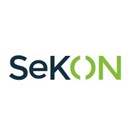
Director, Growth Operations at SeKON Enterprises
“Ms. Pruyne guided me as I worked together through a spectacularly difficult year with the most difficult challenges of my career. There were so many lessons in that time it would be hard to describe all of them, but the most significant shifts for me were learning about Intentional Leadership Communication – transforming difficult conversations into productive connections, speaking with authority, and staying true to myself and the full value I have to offer.
I needed someone who’s “been there, done that” who would point out, put into practice, and reinforce new attitudes and behaviors; someone who is objective and encouraging with empathy but not sympathy. Ms. Pruyne promised that, and she delivered—working with her was the right investment.”
More detailed achievements, references and testimonials are confidentially available to clients upon request.
Client Telephone Conference (CTC)
If you have any questions or if you would like to arrange a Client Telephone Conference (CTC) to discuss this particular Unique Consulting Service Proposition (UCSP) in more detail, please CLICK HERE.
































